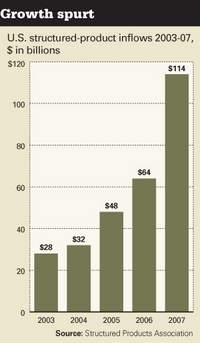By Steven Krawciw and Irene Aldridge
Prime brokerages and their partner private banks provide hedge fund managers with services ranging from execution to capital introductions to lending. One of the areas least utilized by hedge fund managers, however, is a banks’ structuring capability.
The main advantage of structured products is that it allows a fund manager to raise capital from a vast pool of untapped investors. In addition, the bank performs due diligence and finds an appropriate way to package the product, acts as a clearinghouse of the product, and potentially assumes credit liability at maturity of the product. With the number of wealthy retail investors rising worldwide, we are likely to see an increasing number of structuring deals that may benefit hedge fund managers.
“Structuring” refers to the process of creating, packaging and distributing structured products.
“Structured products” is a moniker for a vast array of hybrid, or financially-engineered, products that banks distribute through their networks of financial advisers to their clients. Private clients consider structured products as a credible and affordable way to access a fund, perhaps with principal protection. These retail distribution capabilities comprise an important value-added service by banks that hedge fund managers may not be fully utilizing.
Structured products are typically sold “over the counter” (OTC), which means that unlike their exchange-traded cousins—Exchange-Traded Funds (ETFs) and Exchange-Traded Notes (ETNs)—structured products are private placements. Still, the Securities and Exchange Commission oversees the distribution of structured products, and one needs to have all the proper SEC registrations in order to sell these securities. Another value add by the prime broker is that the broker’s licenses cover a fund’s product and spare the manager having to register with the SEC.
Unlike ETFs, structured products are typically underwritten by a bank. During the underwriting process, the bank performs due diligence analysis, structures the product, and often assumes the counterparty risk. It is also possible for a bank to securitize obligations outstanding on structured products. Whether securitized or not, underwriting of the structured product backed by a fund is the third benefit a bank delivers a fund manager through structuring.
The “structured” part in “structured products” refers to bundling the underlying exposure to a fund with various financial instruments. A typical goal of structuring is to create a product with a custom payout that is appealing to retail investors with a specific risk appetite. For example, a class of structured products known as Principal-Protected Notes (PPNs) provide the retail investor with either a portion of the payout, say, from a fund if it meet its targets. If the fund does not meet its performance targets, then the retail investor holding a PPN will receive his principal back along with the pre-agreed interest rate on that principal. With such a PPN, the retail investor gains exposure to a fund, but is protected from any downside.
So how does the actual structuring work?
For the complete article on FINalternatives.com, click here.
Subscribe to:
Post Comments (Atom)




No comments:
Post a Comment